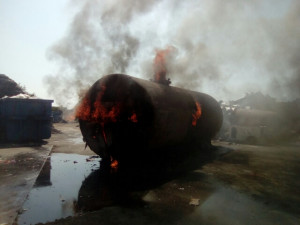At around 11:00 a.m., a fire started on a metal tank at a scrap metal recovery facility whilst a technician was cutting it with a blowtorch. The 30 m³ tank, which contained a residual amount of fuel oil (1 t), ignited when the blowtorch flame came into contact with it. The technician attempted to extinguish the flames with a fire-hose, but was unsuccessful. Firefighters attacked the fire with a hose connected to the public fire hydrant. The flames remained confined within the tank, except at the manholes and the cutting slot. The fire produced a dense column of smoke up to 15 m high. The fire was extinguished at around 12:30 p.m.
An estimated 292 kg of fuel oil burnt, producing 3500 m³ of smoke. The isolation valves were not closed during the fire. The unburnt fuel oil remained confined in the tank. The firewater did not run off beyond a small portion of the concrete slab around the tank. A vacuum tanker pumped out the tank and cleaned the area around it.
The day before the incident, the facility’s former boss, who was often present, had instructed the technician to cut down the tanks because they were taking up valuable space. The site was cluttered due to several months of work on the shear press, which subsequently broke down for three weeks. So, the technician cut an (empty) tank. At around 9:30 a.m. the next day, the technician began cutting the frame of the tank containing the residual amount of fuel oil. At around 10:00 a.m., the operations manager told him not to cut the tank. However, the technician did not listen and resumed cutting the tank without the operations manager realising. The fuel oil residue ignited on contact with the flame of the blowtorch as it pierced into the tank’s shell. The tank was part of a batch that had been delivered in April despite not being completely empty and the absence of a degassing certificate.
The inspection authorities for classified facilities found the following violations when it visited the site:
- The cutting with the blowtorch had been carried out less than 5 m from the storage cubicles containing cardboard and plastic (the authorised distance is not less than 8 m);
- The operator did not have any written operating instructions or emergency instructions;
- The worker who had done the cutting had been with the company for several years but was not trained in fire safety;
- The fire-hoses were not periodically checked and their flow rates were found to be insufficient.
Since the accident, the operator has:
- Trained his employees in the risks associated with flammable substances and fire safety;
- Purchased dry chemical fire extinguishers;
- Reiterated in writing the lines of responsibility and clarified and enforced the organisational chart;
- Posted the list of substances and materials that are prohibited for delivery to the site;
- Tightened the acceptance criteria: tanks and vats delivered without degassing certificates will be prohibited without exception.




